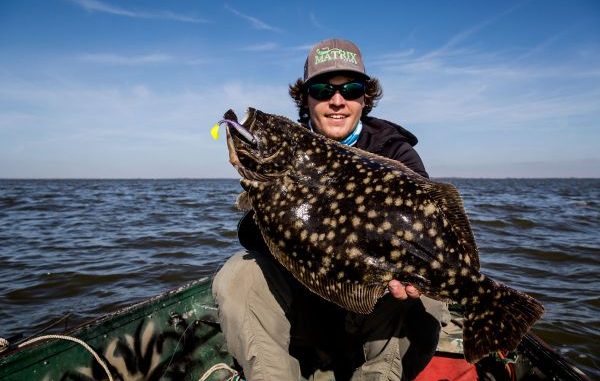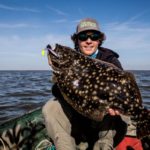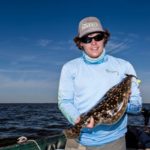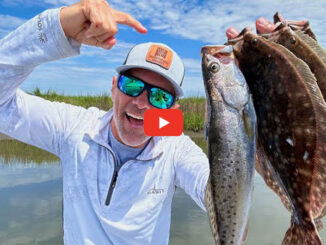
This angler has a habit of putting big door mats in his boat at Pointe-aux-Chenes WMA. Learn the secrets to his success flatfish success.
If Ray Scott had been a flounder fanatic rather than a bass buff, I would have signed up as his first lifetime member of Flounder Masters and granted him easy access to my coffers.
I mean, bass are cool and all, but they’ve got nothing on flounder.
Even if a flounder didn’t have two eyes on the same side of its head, I would still get a little freaked out every time I reeled one in.
In my mind, flounder have always been the junkyard dogs of saltwater fishing, and I would argue that there is no other inshore fish that shows as much guts, grit or gall.
My emotional affair with flounder forces me to constantly peruse social media in search of someone with whom I can hook up.
When I came across the photo Ty Hibbs had posted to Facebook this time last year, I knew he had been living in a flounder fantasy land and that I wanted VIP access.
“No problem,” Hibbs told me. “Can you meet me at Pointe-aux-Chenes on Tuesday morning?”
“Dude, I would meet you at San Francisco on Sunday if it meant I could get on some flounder like those in your photo,” I responded.
To understand my flounder fervor, you would have to see the photo Hibbs posted. It showed Hibbs holding a gigantic flounder in the back of a pickup with a pile of floor mat-sized flounder that were literally serving as a bed liner for his truck.
As we launched his little aluminum boat at the ramp just off Island Road, which spans a portion of the southern Pointe-aux-Chenes boundary, Hibbs told me the flounder he and a friend caught in the photo were a result of perfect timing on their part.
“We had one of those days when a cold front came through at 7 in the morning, and we happened to be standing on the road fishing at the exact same time,” he said. “The reservoir had been up and had been really clear.
“When the northwest wind started blowing, it pulled the plug. Everything fell out, and there were so many — I’ve never seen them stacked up like that — there were so many flounder stacked up by the weir that we caught 3- to 5-pound flounder on every cast, with an occasional 6-pounder or two.
“Then we got on that 7-pounder you saw in the photo.”
As Hibbs idled west toward the weir on Island Road, I had to ask about something I thought I had not heard correctly.
“Standing on the road?” I pressed.
“Yep, we caught every one of those flounder standing on the side of the road,” Hibbs said. “Don’t get me wrong: We weren’t the only ones fishing off the road. But we were the only ones catching those kinds of fish.”
So what was Hibbs doing to catch so many giant flounder when so many anglers were fishing within elbow distance of each other?
That’s exactly what he would spend the next few hours explaining to me.
“These flounder go insane right after the first big monster cold front in October,” Hibbs said as he dropped his trolling motor about 30 yards in front of the Island Road weir. “That front will bring down the water temperature, and it triggers the switch from the summer pattern to the fall pattern.
“That’s when flounder go nuts.”
The only potential problem Hibbs saw that might keep us from replicating his fantasy day a few weeks before was that the weir was not open. Therefore, there was very little to no water movement.
Although it would be nice to be able to plan ahead and schedule fishing trips based on when the weir is open, Hibbs said he’s found no rhyme or reason to when it’s open and when it’s closed.
“I used to think it had something to do with the water level, but that’s not it,” he said, while making his first cast to a 2-foot ledge that quickly fell into 8 feet of water. “I’ve asked my buddies in (the Louisiana Department of) Wildlife and Fisheries, and they don’t have an answer either.
“I guess if you’re lucky it’ll be open. If not, you can still catch fish, but you have to work a little harder for them.”
In fact, Hibbs said the only reason he fishes the weirs so much is because of the concentration of moving water they create. However, the ease of fishing the weirs around Pointe-aux-Chenes makes them magnets for bank-bound anglers.
That’s why he doesn’t mind looking for moving water in the marsh away from the weirs, focusing on deep points or bayous with a hard tide falling around or through it.
But we weren’t in the marsh; we were fishing the weir.
And, even though Hibbs had just cast toward the bank where several anglers were perched, a flounder picked up his bait rather than theirs.
“Got to Bill Dance ’em,” he grunted as he tried to cross the flounder’s eyes. “If you don’t set the hook as quick and as hard as you can, it won’t pierce the bone, and they’ll just drop it.
“If you wait too long, they’ll get it deep and will shred your line.”
Hibbs quickly transitioned from teacher to commander as he instructed me to get the net, which eventually swallowed up the flounder that was desperately trying to avoid it.
As he put our first flounder in his cooler, Hibbs expressed confidence that we could catch some fish even though the water wasn’t running through the weir.
“When it’s running, they stack up on the side of this ledge with their mouths facing into the current, waiting to maul whatever comes by,” he said. “The harder it’s moving, the more ganged-up they get.
“They’re still here when it’s not running, but they spread out a little and you won’t mug them in one spot.”
But this first fish let us know that the flounder were still around. And by moving back and forth in front of the weir and rocky road on either side, Hibbs and I put a whipping on some door-mat flounder with me wondering the whole time how we were catching so many big fish while all those around us only boated little fish.
The answer was simple, Hibbs said.
“They’re all fishing with cocahoes,” he said, “and they’ll catch a lot of fish. You’ll actually get more bites on a cocahoe than you will these plastics, but you won’t catch nearly the same size fish.
“For these big flounder, I like jigging a soft plastic with a big profile.”
For most of the day, Hibbs threw a purple haze Vortex Shad on a 3/8-ounce jighead while I threw a new penny Gulp Shrimp.
Although I caught some flounder, it was obvious that the bigger flounder fell for Hibbs’ Vortex Shad Hibbs.
“I use the Vortex Shad because it has a bigger profile than the Matrix Shad,” Hibbs explained. “It’s not all that much bigger, but it has a bigger tail that adds to the effect.
“I think these flounder are looking for something with a big profile that looks like a pinfish, not a shrimp. Big fish would rather eat a 6-inch mullet than a 60-count shrimp any day of the week.”
And it was evident that Hibbs wasn’t shy about jigging the fire out of his Vortex Shad. Rather than barely crawl it on bottom, he imparted a lot of action to his bait by quickly and violently popping his rod to make his bait jump way up off bottom before crashing back down to bottom.
“I want to make sure they see it,” he said. “I don’t think you can go wrong slow dragging it on bottom, but I like my baits to bounce around a lot.
“Flounder are aggressive fish, and I want to trigger that aggression with a power presentation.”
After the bite died down at the first weir, Hibbs ran over to a weir to the west that he hoped might be open. It wasn’t, and we didn’t even get a bite.
Rather than beat a dead horse, we ran back to the first weir and tried to expand our bite by working the rock levee of Island Road.
It was only when we got back around the ledge in front of the Island Road weir that we found more success.
“No doubt this is kind of like my go-to spot,” Hibbs said. “When my back’s against the wall, it seems like I can come here and pick up some fish. I don’t necessarily think it’s the best weir in the Point-aux-Chenes management area, but it’s definitely the easiest to fish.”
The 7 ½-pound flounder Hibbs stuck just a few casts later must not have liked the avid angler dismissing the Island Road weir as not being the best in the area.
“What can I say?” Hibbs concluded. “Just when you think you’re not going to catch a big one, this old weir just jumps up and spits out another one.
“I’d like to go fish some of the other ones, but I’m not leaving this one until we catch his sister.”
Ah, his sister. Maybe I could catch her and finally meet my perfect match.


